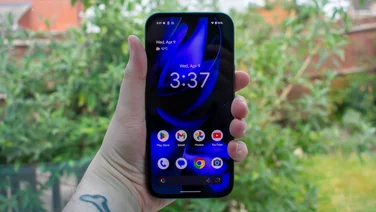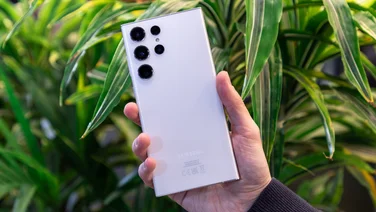To help us provide you with free impartial advice, we may earn a commission if you buy through links on our site. Learn more




























- Much improved performance
- Great battery life
- Mostly excellent cameras
- Only three years of OS updates
- Video capabilities are disappointing
- No bundled fast charger
The Motorola Edge 60 Pro needed to make some dramatic changes to the formula in order to compete with this year’s best smartphones. Its predecessor, the Edge 50 Pro, carved out its own niche by squeezing in a telephoto camera – something usually reserved for flagship phones.
With cheaper handsets adding telephoto since then, however, a new approach was needed. And, for the most part, this change in direction has been very successful. Motorola has massively rebalanced the specs and, in the process, addressed the biggest issues with last year’s handset.
The result is a smartphone that feels much more compelling and well-rounded than the Edge 50 Pro, but the relatively short software support roadmap still leaves the Motorola Edge 60 Pro at a disadvantage.
Motorola Edge 60 Pro review: What you need to know
Chief among the big changes is a massive 6,000mAh battery, a sizeable jump from the Edge 50 Pro’s 4,500mAh cell. Balancing this out, however, is the charging, which has dropped slightly from a blisteringly fast 125W to (a still pretty good) 90W for wired and from 50W to a measly 15W for wireless. The final blow here is that there’s no charger in the box this time.
There’s also a new processor, swapping out last year’s Snapdragon chip for a Mediatek Dimensity 8350 Extreme, clocked at up to 3.35GHz and backed by 12GB of RAM and 512GB of storage.




























The display is once again a 6.7in pOLED panel with a resolution of 1,220 x 2,712, but the refresh rate has dropped slightly, from 144Hz to 120Hz. Last year, I called the Edge 50 Pro’s 144Hz refresh rate overkill, so this feels like a smart concession to me.
The 50-megapixel main camera now has a narrower f/1.8 aperture (compared to last year’s f/1.4) and the 50-megapixel selfie camera’s aperture has dropped from f/1.9 to f/2.0. The 10-megapixel, f/2.0, 3x telephoto camera is the same as last year but the ultrawide has been swapped out for a sharper 50-megapixel unit (up from 13MP) with an f/2.0 aperture.
Finally, as we saw with the Motorola Razr 60 Ultra, there’s a new button high up on the left edge that serves as a fairly unnecessary shortcut to the phone’s various AI functions.
Price and competition
Despite all these changes, the price remains the same £600 as last year. This is near the ceiling of what we’d consider to be a mid-range phone and is a particularly popular pick, with no shortage of competition.
Leading the pack is the Google Pixel 9a, which costs £499 for the 128GB model or £599 for the 256GB. The big benefit of Google’s mid-ranger is the massive seven years of software support, but it also offers class-leading cameras and some of the best phone battery life we’ve ever recorded.




























Samsung and Apple also have phones around this price, with the Samsung Galaxy A56 costing £499 and the iPhone 16e starting at £599 for the 128GB model – although you’re looking at £899 for the equivalent 512GB of storage.
If you want hefty storage for a similar price to the Motorola, the Oppo Reno 13 Pro offers the same 512GB for £649. Performance is a little slower on this one but, like the Pixel, it blew our battery test out of the water, delivering some of the best stamina we’ve ever seen.
Design and key features
The Motorola Edge 60 Pro again weighs 186g but it’s a smidge shorter and wider than the Edge 50 Pro, now measuring 73 x 8.2 x 161mm (WDH). This isn’t dramatic enough to change the aspect ratio (still 20:9) but it does feel slightly better proportioned than the Edge 50 Pro, which always felt just a little too narrow and tall for my liking.




























Dust and water resistance gets a minor upgrade to IP68/IP69, adding protection against high-pressure jets of water from any direction alongside the dust-tight status and the ability to withstand being submerged in 1.5m of fresh water for up to 30 minutes. There’s also a layer of Gorilla Glass 7i over the display for scratch protection.
Speaking of which, the new quad-curved display isn’t going to be to everyone’s tastes; it’s slightly 3D, rolling elegantly off to all four edges, which makes the phone feel that little bit slimmer in the hand, but on the other hand, content on the far edges can look slightly dimmer than on the central screen.




























The rear, which is slightly curved as well, comes in three Pantone-approved colours and two different finishes. The greyish “Shadow” I’m reviewing and the purple “Grape” style are both backed by the vegan leather we’ve seen on Moto phones for a while now, while the aptly named Dazzling Blue is coated with a nylon-inspired material that’s soft to the touch but textured enough that you aren’t sacrificing grip.
On the software front, the Edge 60 Pro runs Android 15 out of the box and is due for three years of OS updates and four of security patches. Moto’s clean and simple UI is a big bonus here, but that software support pales in comparison with the likes of the Google Pixel 9a and Samsung Galaxy A56, which get seven and six years of support, respectively.




























The Edge 60 Pro also heralds the official debut of Moto AI, having been in open beta for the last few months and this brings the expected slew of productivity focused features such as note summarisation, audio transcription and a brief overview of your current notifications. More interesting is the personalised Next Move feature, which suggests further actions – such as creating a travel itinerary or playlist – based on your previous activity and the content on the screen.
Display
The 6.67in pOLED display is near-enough identical to last year, which means that it’s once again an excellent panel. The 1,220 x 2,712 resolution keeps things looking sharp and the 120Hz refresh rate is still beautifully smooth in operation. The peak brightness levels of 476cd/m2 in manual mode and 1,068cd/m2 in auto are around the same as the Edge 50 Pro, but HDR brightness was lower, at 1,302cd/m2 versus 1,690cd/m2. That’s still excellent, however, and not a difference you’re likely to notice.




























As with all recent Motorola phones, you get three colour profiles to choose from, with the default Vivid and Radiant settings offering different levels of punchy, saturated colours, while Natural aims to accurately reproduce the sRGB colour space.
On the latter setting, I recorded an sRGB gamut coverage of 97.3% and a total volume of 99.4%. The average Delta E colour variance score of 1.42 is a little higher than the target (1 or under) but it’s not disparate enough for colours to look out of place.
Performance and battery life
Poor performance was one of my biggest criticisms of the Edge 50 Pro, so it’s great to see the new Mediatek Dimensity 8350 Extreme chip deliver the goods in the Geekbench 6 benchmarks. In the single-core portion of the test, the Edge 60 Pro outperformed its predecessor by 26%, while its multi-core results were even better, gaining a fantastic lead of 43% over last year’s model.
These results put the Edge 60 Pro roughly on par with the Google Pixel 9a at the front of the Android pack – although the iPhone 16e’s blisteringly fast silicon still puts it leagues ahead.
The Edge 60 Pro also did very well in the GFXBench GPU tests – something that could not be said for its predecessor. With onscreen (at native resolution) results twice that of the Edge 50 Pro and offscreen (1080p) framerates close to double as well, the Edge 60 Pro is far more suited to smooth 3D gameplay than its older sibling.
Indeed, I ran Genshin: Impact on the default graphical settings and the Edge 60 Pro kept gameplay smooth and responsive without interrupting me with annoying lag or overheating issues.
That bigger 6,000mAh battery delivered in our looping video battery test, too, with a result of 30hrs 35mins coming in nearly ten hours better than the Edge 50 Pro. That’s one of the best results in the price range, with only the Pixel 9a and Oppo Reno 13 Pro lasting any longer, and should happily see you through your day without needing to worry about hunting down a charger.
The lower charging speeds and much larger battery mean that the Edge 60 Pro won’t be joining its predecessor atop our fastest charging phones ranking any time soon, but for this price, 90W charging is still very good. In my testing, it brought the battery up to 50% in 21mins and on to full in around 50mins, which should be plenty fast for most people.
Cameras
The 50-megapixel main camera has a narrower f/1.8 aperture than last year, but is otherwise a dead ringer, including optical image stabilisation (OIS) and Phase Detection Auto Focus (PDAF), which work to keep your shot steady for better detail retention and quickly lock onto your subject for speedy snapshots.
That certainly tracks with my testing. Shots captured in good lighting are nicely detailed with natural colours and solid dynamic range. The only issue I encountered with this lens is that, in particularly bright conditions, the highlights and contrast feel a little off, leaving the final image looking quite washed out.

I already wasn’t that blown away by the night photography on the Edge 50 Pro, and the narrower aperture here doesn’t do the Edge 60 Pro any favours. If there’s some artificial lighting around, the shots come out relatively well, though the images are still a little dull, and once again, there’s an unnatural yellow hue over the entire image.

The 10-megapixel (f/2.0) 3x telephoto lens is primarily meant for portrait shots and it’s clear why. Skin tones are rendered with natural tonality and the detail levels are fantastic, plucking out fine hairs against a smooth background blur. We’ve got PDAF and OIS support here, too, which helps if you’re trying to get a close-up of a skittish subject, like this camera-shy Orchid Mantis:

It’s rare that an ultrawide camera stands out from the pack but, out of the three rear lenses, this one feels the most improved from last year. The 50-megapixel sensor does a great job of retaining detail (barring those tricky corner areas, of course) and the exposure and colour tone are well matched with the main camera.

The ultrawide camera pulls double duty and handles macro shots, as well. Once again, that higher pixel count really makes this a worthwhile inclusion, with excellent definition in the finer details and clear outlines around your focal point.

Where this camera suite falls down, however, is video. It still can’t capture 4K at 60fps and the main camera’s OIS support doesn’t extend to video recording. And the electronic stabilisation you do get isn’t great, either; in my testing, I noticed plenty of sway and hand-shaking.
Motorola Edge 60 Pro review: Verdict
The lack of a fast charger in the box is disappointing, but it’s really the camera wobbles and relatively short software support that hold the Edge 60 Pro back from greatness. If Motorola had addressed these two points while keeping the price competitive, we could have been looking at a serious rival for the Google Pixel 9a.
As things stand, however, extra storage is about the only thing that gives Motorola the edge (so to speak) over Google. The Motorola Edge 60 Pro is a stylish and competent phone, but for everything it does well, the Pixel 9a does just as well or even better while offering much longer software support.




